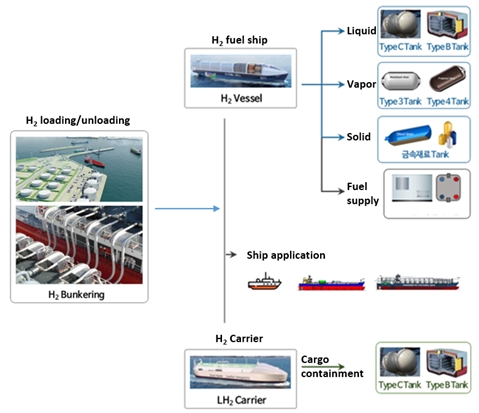Hydrogen Carrier & Hydrogen Bunkering
-
The application of hydrogen energy in shipping can be divided into two categories. One is a technology applied to transport hydrogen, and the other is a technology for onboard power generation by using a fuel cell system. The "Roadmap for Activating the Hydrogen Economy," published by the Korean Government in January 2019, includes development strategies for these two categories.
Transportation of hydrogen by ship could be a practical method for very large quantities and over long distances, namely, international transport. Hydrogen can be transported via ship in the form of ammonia (NH3), and organic compounds (LOHC: Liquid Organic Hydrogen Carrier) or liquid hydrogen (LH2). In this field, Japan is leading the way in developing technologies. Korea started research into transporting liquid hydrogen in 2016.
Hydrogen strategy in Japan (source: METI)
-
To develop the liquid hydrogen tanker, first and foremost, it is necessary to develop and secure core technologies, such as cryogenic insulation technology, loading/unloading technology, and BOG treatment technology. Currently in Korea, cargo containment systems (CCS) to hold liquid hydrogen on a liquid hydrogen tanker has been developed by an R&D project led by the Korean Register (KR)
Three major shipbuilding companies (Samsung Heavy Industries, Hyundai Heavy Industries, and DSME) and related manufacturers and universities participated in this project. The necessary parameters and simulation results for design and test regulations were secured for ship application. In the near future, other core technologies have to be secured, and ships have to be constructed for demonstration, and tested for verification of safety. After then, liquid hydrogen tankers could be commercialized in 2030, the year in which the hydrogen economy is planned to begin.
Basic design of membrane-type CCS (source: SHI)
-
Following the announcement of ‘Hydrogen Economy Vitalization Roadmap’ in January 2019, Republic of Korea enacted the world’s first ‘Hydrogen Law’ in February 2020, launched the ‘Hydrogen Economic Committee’ in July 2020, and increased its R&D budget from KRW 85.5 billion in 2019 to KRW 240 billion in 2021 to build an institutional foundation for promote the country's hydrogen economy.
According to Seoul's ‘1st hydrogen economy implementation basic plan’, published in November 2021, hydrogen as a single energy source is expected to account for 33% of final energy consumption by 2050, replacing the oil energy (49.3%, as of 2020). As hydrogen produced overseas is expected to account for the majority, it is important to build hydrogen energy infrastructure such as energy loading/unloading and storage facilities. The plan also urged to establish safety standards for the use of hydrogen in ships frequently used to transport and load/unload the gas.
Accordingly, KR is developing technologies for hydrogen transportation and safely securing hydrogen fueled ships with related institutions. Through the development of related system Generic Model, risk assessment, and safety standards development, KR supports the development and operation of hydrogen ships required by the industry. The safety technology for hydrogen ship-related bunkering and loading/unloading, storage containers and fuel supply systems, integrated control systems, and the hydrogen industry will enable Korea to gain an upper hand in the global hydrogen market.
Hydrogen application in marine industry (source : KR)
-
KR will provide high-quality technical support to manufactures and customers through R&D.
Image of LH2 Carrier (source: KR)



